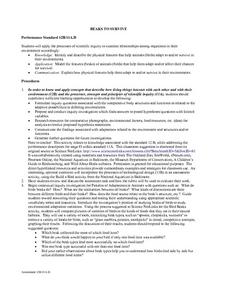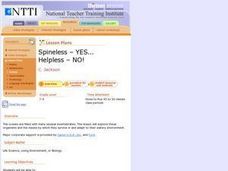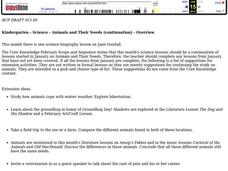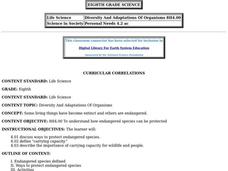Curated OER
Evolution Explorations
Students compare characteristics of animals and human beings. In this biology lesson, students observe an animal and record their observations. They infer whether the evolution theory is true or not.
Curated OER
Earthworm Movement and Landscape Structure
Students describe differences in animal usage of habitats depending upon successional status of site. They also design other experiments to test movement patterns of animals through habitats of differing structure.
Curated OER
Dinosaur History (Part 5)
Eighth graders read the scripture that cooresponds with this lesson on dinosaurs. As a class, they review the great flood and discuss how the animals on the ark repopulated the Earth. They read more verses and answer questions to be...
Curated OER
Beaks To Survive
Students discuss and identify the types of adaptations that are made by different organisms in order for them to survive. In groups, they describe the features of beaks and discuss how it affects their chances for survival. They share...
Curated OER
Social Studies: The Human and Animal Connection!
Students infer the connection among humans, animals, and disease through the interpretation of concept maps. They are introduced to the idea of a connection human disease and the domestication of animals.
Curated OER
Design an Exhibit
Students play the roles of exhibit designers in a zoo as they create a new exhibit for herps--amphibians and reptiles. They consider all the needs--light, heat, etc.
Curated OER
Biodiversity Bird Hunt
Learners examine the influence of biodiversity on human culture through the use of birds. They brainstorm words that come to mind when they think of human cultures. They describe ways that human culture and biodiversity are linked.
Curated OER
What Do Koalas Need to Survive?
First graders take a field trip and examine the Koala and his habitat. In this Koala lesson, 1st graders read Possum Magic and discuss the foods of Australia. Students view the habitat of a Koala and record what it eats, its physical...
University of California
Plankton
Plankton: so much more than just a SpongeBob character. Three different activities have kids looking at both phytoplankton and zooplankton in pictures, as well as collecting their own samples (depending on your access to a saltwater...
Curated OER
Cloudy With a Chance of Meatballs
Fourth graders participate in a play to work on seeing events from a different perspective. Some of them are reporters, some cameramen and women, and others are interviewed. They put themselves in the shoes of the people in the book...
Curated OER
Listen and Draw
Students use their visualizing and interpreting skills to produce original writings and drawings. First, they listen to an adaptation of William Clark's description of the sage grouse. They form mental images that they translate into...
Curated OER
Deserts: How Do You Define One?
Second graders identify what constitutes as a desert by reading a habitat checklist. In this environment lesson plan, 2nd graders read a nature website to discover facts about the desert and where they are located. Students utilize art...
Curated OER
Habitats
Second graders identify characteristics of various habitats. In this habitats lesson, 2nd graders read Where the Forest Meets the Sea and Swimmy to identify the settings of different habitats. Students construct murals of different...
Curated OER
"Julie of the Wolves"
Fifth graders research life in Alaska and compare life there to their lives in this instructional activity. They read "Julie of the Wolves." They research through the novel and other reference books facts about the Alaskan climate and...
Curated OER
Our Families, Yours, and Mine
Students study the similarities and differences in families and identify attributes in themselves and others.
Curated OER
Spineless - YES... Helpless - NO!
Students distinguish between invertebrate and vertebrate organisms while examining the zoological classes of a number of invertebrates. They illustrate a food web of these organisms and investigate the impact of humans on the oceanic...
Curated OER
Jane Goodall
Students identify Jane Goodall as a scientist who studies the behavior of chimpanzees. They listen to a biography of Jane Goodall and review the location of Africa. Then students participate in an animal observation activity.
Curated OER
Diversity and Adaptations of Organisms
Eighth graders discuss ways in which to protect endangered species. They examine the concept of carrying capacity. They discuss the importance of carrying capacity for wildlife and people.
Curated OER
Life on the Edge
Students participate in a variety of activities about endangered animals. They read books, watch videos, and, in pairs, choose an endangered animal to research. They create a 2 slide presentation to be compiled into a class slide show.
Curated OER
Green Space in the City
High schoolers identify the different kinds and uses of green space that exist in an urban area. They create maps of local parks and research the history of each park. They conduct a survey of residents near the park and interview a park...
Curated OER
Green Space in the City
Students examine city parks and their importance and affect they have on the health and well being of a community. An oral report with visual aids is prepared as a group to educate the class on the importance of green space in the city.
ReadWriteThink
Read Write Think: Webcams in the Classroom: Animal Inquiry and Observation
Observe animal behavior patterns and their habitats using one of the many webcams broadcasting from zoos and aquariums around the United States and the world in this inquiry-based activity that focuses on observation logs, class...























